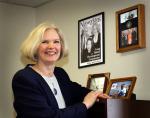AIt is not usual for orchestral pieces to follow a story-though pieces like Nutcracker Suite have individual segments like "The Dance of the Sugar Plum Fairy" and so on. The Sorceror's Apprentice is what is known as a tone poem-where different emotions are expressed by an overall story-in this case Goethe's poem, The Sorceror's Apprentice?
AQuit a few. Throughout time, there have been many different versions of the film released, although all of them feature the same music and the same animated cartoons.1) The original version of Fantasia, exhibited in special traveling roadshow engagements by Walt Disney Productions, ran 124 minutes, plus a 15-minute intermission, and was presented in four-track stereo sound (Fantasound).2) In 1941, RKO took over the roadshow bookings from Disney and had Fantasia's soundtrack remixed into monaural sound.3) For its first wide release in January 1942, RKO had the film edited down to a mere 81 minutes and re-issued it with the tagline "Fantasia will Amazia!" Practically all of the Deems Taylor interstitial footage was removed, as well as the entire "Toccata and Fugue in D Minor" sequence. This chopped version of the film (which was usually booked in theaters as a B-picture) did disastrous box-office and was pulled from distribution after a relatively short run.4) In 1946, Fantasia was re-edited to a 115-minute running time. "Toccata and Fugue" was restored, but most of Deems Taylor's introductions were kept as short as possible. This is the version of Fantasia that is the most familiar to the public, and is referred to as the General Release Version. It omitted Deems Taylor's mention of an intermission, which occurs right after the end of "The Rite of Spring" in the roadshow release, and since then, the film, when shown in theatres and released on videocassette, has gone straight from the end of "The Rite of Spring" to the jam session and then the "Meet the Soundtrack" segment, with no break whatsoever.5) In February 1956, the General Release Version was re-released in widescreen 2.00:1 SuperScope, with the film image cropped to conform to the anamorphic widescreen ratio. The stereophonic Fantasound tracks were re-mixed into four-track optical sound for this release, marking Fantasia's first wide release in its originally intended stereo sound. This was the first time that the soundtrack of "Fantasia" was heard in stereo since 1940. It would be re-released in stereo in 1963. (In fact, there may be doubt as to this 1956 release being the one utilizing SuperScope; some remember that pseudo-widescreen process in which an anamorphic lens spread out and distorted the animated sequences appeared in the 1963 release during the "hippie" era.)6) For a 1969 re-release, scenes featuring a Black-looking female centaur acting as a servant were edited out of the "Pastoral Symphony" sequence because of concerns over racial stereotyping. This version of Fantasia, otherwise identical to the General Release Version would be reissued in 1977, again in stereo. All future versions of the film would omit scenes of the Black centaur.7) Disney attempted to restore the 1956 stereo soundtrack for a 1982 reissue, but it could not create a satisfactory version that met the standards of film releases at the time. Therefore, Disney decided to completely re-record the film's soundtrack with a new digital recording arranged and conducted by Irwin Kostal, marking it the first-ever release of a motion picture with digital stereo sound. Deems Taylor was not seen in this version; voice-over narration was provided by Hugh Douglas. This version proved unpopular, since it was not Stokowski conducting the music, and because the Philadelphia Orchestra was not heard on the soundtrack, but instead a studio orchestra. The 1982 digital stereo version would be the version released again in 1985.8) For Fantasia's 50th anniversary in 1990, extensive digital restoration techniques allowed for the creation of a satisfactory audio master of Stokowski's original Philadelphia Orchestra recordings in Fantasound. The film's visuals were also extensively restored, although the film was edited to resemble the General Release Version closely. The only major addition to the film at this point was a closing-credits sequence that used the footage from the roadshow intermission for a backdrop, which had never been added to any previous version of the film. The 50th anniversary version was released on home video in 1991.9) For the 60th anniversary of Fantasia in 2000, the film's picture and sound were restored a second time, using digital techniques. This time, however, the film was restored to its original 1940 length and format, save for two changes: a) the Black centaur servant was omitted from the film using a combination of digital zooming and digital editing of the picture, and b) as the original sound elements for the extended versions of the Deems Taylor scenes could not be found, voice actor Corey Burton was brought in to re-dub all of Taylor's dialogue. Contrary to some beliefs Taylor's actual voice is never heard in the 2000 DVD version. As in the original roadshow release, no written credits appear on the screen at all, except for a title card saying "Fantasia" which appears at the intermission break. (All releases of "Fantasia" from 1941 up until 2000 showed the title card at the beginning of the film, not halfway through.)












